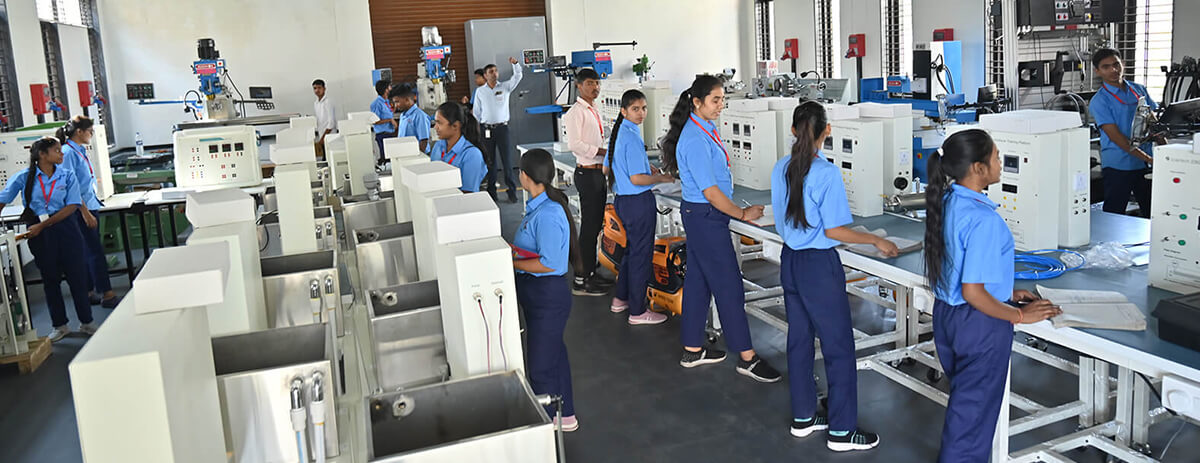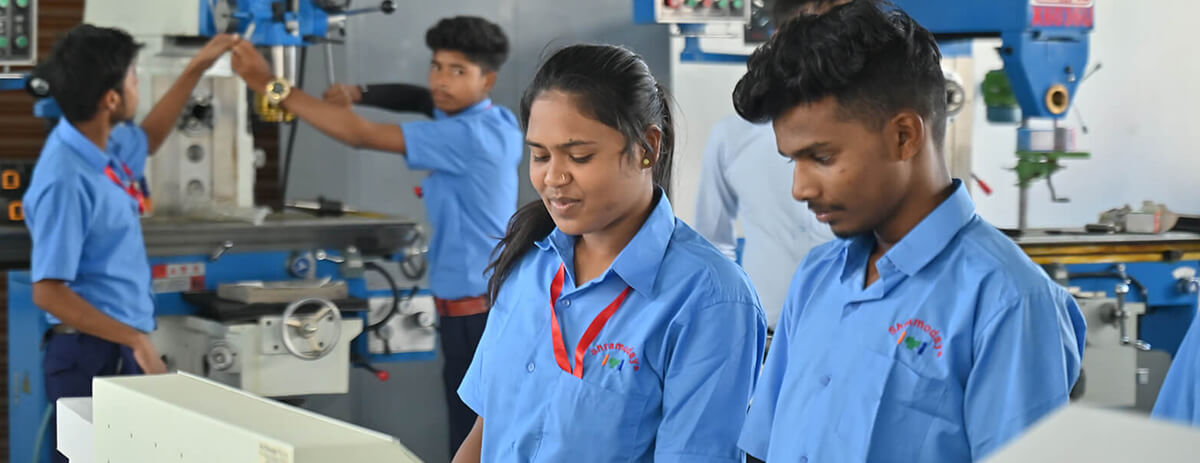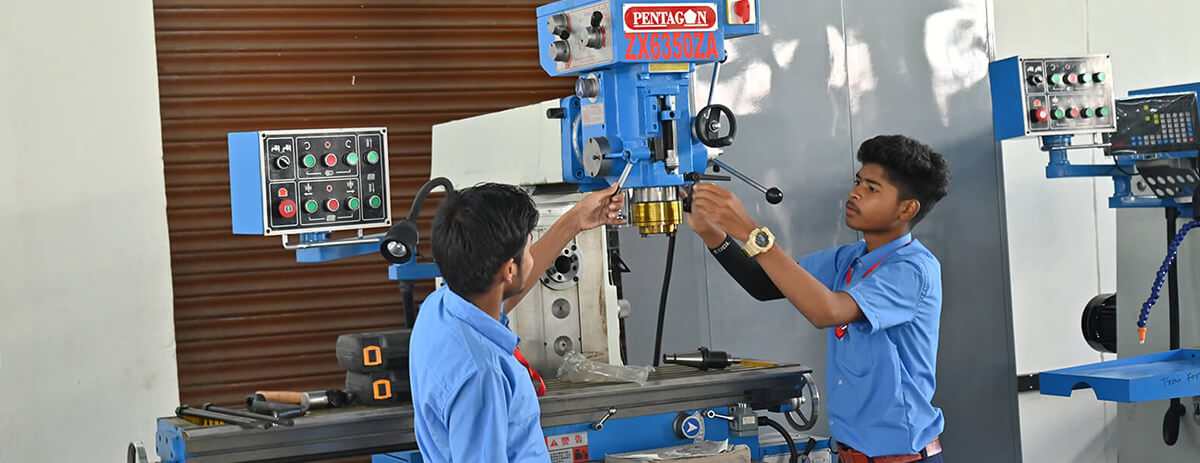TECHNICIAN MECHATRONICS: GENERAL INFORMATION
Click to see more images| Name of the Trade | TECHNICIAN MECHATRONICS (Engineering Trade) |
|---|---|
| Trade Code | Trade Code DGT/2001 |
| NCO - 2015 | NCO - 2015 7233.0100, 7233.0101, 7412.0101, 7412.0201, 7411.0100, 7421.0300 |
| NOS Covered | TSC/N5702, TSC/N9015, TSC/N5703 CSC/N9452, CSC/N9453, CSC/N9454, CSC/N9455, CSC/N9456, CSC/N9457, CSC/N9458, CSC/N9459, CSC/N9460, CSC/N9461, CSC/N9462, CSC/N9463, CSC/N9464, CSC/N9465, CSC/N9466, CSC/N9467, CSC/N9468, CSC/N9469, CSC/N9470, CSC/N9471, CSC/N9472, CSC/N9473, CSC/N9474, CSC/N9475, CSC/N9476 |
| NSQF Level | Level – 4 |
| Duration of Craftsmen Training | Two Years (2400 hours + 300 hours OJT/Group Project) |
| Entry Qualification | Passed 10th class examination with Science and Mathematics or with vocational subject in same sector or its equivalent. |
| Minimum Age | 14 years as on first day of academic session. |
During the two years duration a candidate is imparted training on subjects Professional Skill, Professional Knowledge and Employability Skills related to job role. In addition to this a candidate is entrusted to make/do project work and Extra Curricular Activities to build up confidence. The practical skills are imparted in simple to complex manner & simultaneously theory subject is taught in the same fashion to apply cognitive knowledge while executing practical task.
The course broadly covers all aspect of Skills required to work in the field of Mechatronics.
TECHNICIAN MECHATRONICS : Year wise Trade Overview
FIRST YEAR: In this year, the practical part starts with basic fitting work to make job as per specification applying different types of basic Fitting and machining viz., Drilling, Turning, Milling and Grinding operations. The trainee will be able to Produce components by different operations and check accuracy using appropriate measuring instrument. Apply different fits for assembling of components as per required tolerance, observing principle of interchangeability and check for functionality. Produce components involving different operation on Lathe, Milling and Grinding machine observing standard procedure and check for accuracy. The candidates also learn about basic computer operation such as MS-Office and basic troubleshooting related to the computer. The welding and brazing are also covered during this year. The safety aspects cover components like OSH&E, PPE, Fire extinguisher, First Aid and in addition 5S of Kaizen is being taught.
The imparted training on basic Electrical and Electronics sub-systems and its measuring techniques using appropriate Measuring instruments, Operate and troubleshoot AC/DC machines and drives. Acquire the skill of reading and analyzing Electrical and Electronics drawings. Construct, analyze and troubleshoot Electrical and Electronic circuits. Assemble and Disassemble Electrical and Electronic components by Soldering and de-soldering techniques. Carry out Industrial panel wiring. Understand and troubleshoot Protective devices in Electrical system. Understand the Digital logic circuits and its applications. Acquire computer skills such as Software installation. Knowledge onbasicprogramming of Microcontroller and its Interfacing techniques, troubleshooting of electrical & electronics system are also covered.
SECOND YEAR: Operates CNC turn centre and CNC milling machine to produce simple components. The trainee also gets knowledge of different sensors viz., inductive, capacitive, magnetic etc and carries out related practical on the same. The student understands the principles of hydraulics, the basic functions of hydraulic systems andthe functions of valves (flow control, pressure control, directional control). Attain the skill of reading and analyzing Hydraulic and Pneumatic drawings. Recognize circuit symbols and diagrams to ISO 1219, construct basic hydraulic circuits as per drawings, understand and follow safe practice.Acquire the knowledge on the functions of power packs, pumps, filters and reservoirs.Understand the units and measurement scales associated with compressed air system.Understand the functioning of standard pneumatic cylinders and valves, read pneumatic circuit diagrams and understand Pneumatic symbols. Construct simple pneumatic controls as per drawing.Read, understand and analyze Electro-Pneumatic circuit diagrams, understand fundamental terminology and symbols of Electro-Pneumatic control, understand the function and operation of a range of proximity sensors, read, interpret and construct motion diagrams. Construct multicylinder control circuit.Fault diagnostics procedure and Troubleshooting of Hydraulics and Pneumatics sub-systems. Executes programming on PLC.
The Trainee gets awareness on Robotics and its application, the trainee will be able to develop, test and troubleshoot circuits using simulator software for Electrical, Electronics, Hydraulic and Pneumatic systems. Able to fabricate and assemble while working model project on Mechatronics [Example: Project-“Pick and Place Mechatronics system” involving Fitting, Drilling, Turning, Milling, Grinding, Electrical wiring, programming, Hydraulic circuit assembly, Pneumatic circuit assembly, Drives, system assembly and Interfacing, functional testing, trouble shooting and repair. Safety measures in each stage.]
GENERAL
The Directorate General of Training (DGT) under Ministry of Skill Development & Entrepreneurship offers a range of vocational training courses catering to the need of different sectors of economy/ Labour market. The vocational training programmes are delivered under the aegis of Directorate General of Training (DGT). Craftsman Training Scheme (CTS) with variants and Apprenticeship Training Scheme (ATS) are two pioneer schemes of DGT for strengthening vocational training.
CTS courses are delivered nationwide through network of ITIs. The course ‘Technician Mechatronics’ is of two-year duration. It mainly consists of trade (skills and knowledge) and Core area (Employability Skills). After passing out of the training program, the trainee is awarded National Trade Certificate (NTC) by DGT which is recognized worldwide.
Trainee broadly needs to demonstrate that they are able to:
- Read & interpret technical parameters/documentation, plan and organize work processes, identify necessary materials and tools;
- Perform tasks with due consideration to safety rules, accident prevention regulations and environmental protection stipulations;
- Apply professional knowledge, core skills & employability skills while performing the job, and repair & maintenance work.
- Check the job/ assembly as per drawing for functioning identify and rectify errors in job/ assembly.
- Document the technical parameters in tabulation sheet related to the task undertaken.
PROGRESSION PATHWAYS
- Can join industry as Technician and will progress further as Senior Technician, Supervisor and can rise up to the level of Manager.
- Can become Entrepreneur in the related field.
- Can take admission in diploma course in notified branches of Engineering by lateral entry.
- Can join Apprenticeship programme in different types of industries leading to National Apprenticeship certificate (NAC).
- Can join Crafts Instructor Training Scheme (CITS) in the trade for becoming instructor in ITIs.
- Can join Advanced Diploma (Vocational) courses under DGT as applicable.
COURSE STRUCTURE
Table below depicts the distribution of training hours across various course elements during a period of two-year is as follows:
| S No. | Course Element | Notional Training Hours | |
|---|---|---|---|
| 1 st Year | 2nd Year | ||
| 1 | Professional Skill (Trade Practical) | 840 | 840 |
| 2 | Professional Knowledge (Trade Theory) | 240 | 300 |
| 3 | Employability Skills | 120 | 60 |
| Total | 1200 | 1200 | |
Every year 150 hours of mandatory OJT (On the Job Training) at nearby industry, wherever not available then group project is mandatory.
| 4 | On the Job Training (OJT)/ Group Project | 150 | 150 |
|---|
Trainees of one-year or two-year trade can also opt for optional courses of up to 240 hours in each year for 10th/ 12th class certificate along with ITI certification, or, add on short term courses.
LEARNING OUTCOMES
- Plan and organize the work to make job as per specification applying different types of basic fitting operation and check for dimensional accuracy following safety precautions. [Basic fitting operation – Filing, Marking, Hack sawing, Drilling, Taping, chipping and Grinding etc. Accuracy: ± 0.1mm] (CSC/N9452)
- Perform different fit of components for assembling as per required tolerance observing principle of interchangeability and check for functionality. [Different Fit –Open & Square Fit; Required tolerance: ±0.05 mm] (CSC/N9453)
- Produce components involving different operations on Lathe, Milling and Grinding machines observing standard procedure and check for accuracy. (Different Operations – facing, plain turning, step turning, parting, chamfering, shoulder turn, grooving, knurling, threading (external ‘V’ only), plain milling, step milling, grooving, slot milling, profile milling, surface grinding and cylindrical grinding (internal and external) (CSC/N9454)
- Perform different computer operation and troubleshoot. [Different computer operations: setting of computer & MS Office operation] (CSC/N9455)
- Perform joining of metals by welding and brazing observing standard procedure. (CSC/N9456)
- Construct different electrical sub-systems and measure parameters. [Different electrical sub-systems: - AC/DC Motors, DC machine, DC motors, DC motor starter, Universal motor, Induction motor, AC drive, Servo drive, transformer.] (CSC/N9457)
- Construct different electronics sub system and test electronic devices and sub system. [Different sub system: - Diodes, rectifier circuit, voltage regulator, transistor power electronic devices, op-amp circuit, LED circuit, SCR etc.] (CSC/N9458)
- Estimate and perform panel wiring using cables, connectors, Protective devices and test functionality. (CSC/N9459)
- Construct and verify different Digital Logic Circuits. [Different DLC:- Logic Gates, half & full adder, binary & outer, P/ down counter.] (CSC/N9460)
- Install different software in computer system and test. [Different software: Office, Multimedia, Fluidism, PLC, etc.] (CSC/N9461)
- Write an assembly level programme and interface peripherals to 8051 Microcontroller to check functioning. (CSC/N9462)
- Troubleshoot and repair different Electrical, Electronic systems/ devices. [Different Electrical, Electronic systems/ devices:- Fuse, MCB, Power circuit, Control panel, Circuit Breaker, Stabilizer, AC/DC drives.] (CSC/N9463)
- Demonstrate function of different sensors. [Different sensors: Proximity Sensors, inductive sensor, capacitive sensor, magnetic sensor, Reflex Photoelectric Sensors, Temperature Sensors, etc.] (CSC/N9464)
- Read and apply engineering drawing for different application in the field of work.
- Demonstrate basic mathematical concept and principles to perform practical operations. Understand and explain basic science in the field of study.
- Set (both job and tool) CNC turn centre and milling machine to produce simple components as per drawing. (TSC/N5702, TSC/N9015)
- Construct simple pneumatic control system to measure various parameters using transducer, sensor and switches. [Various parameter: pressure, flow, level of oil, load displacement] (TSC/N9015)
- Check various components of pneumatics system and construct pneumatic circuit to check functionality. (TSC/N9015)
- Construct an electro-pneumatic circuit and check functionality of a process. [E.g.process: Automatic braking system.] (CSC/N9465)
- Install an electro-pneumatic system and trouble shoot faults. (CSC/N9466)
- Construct simple hydraulic circuit and check functionality. (CSC/N9467)
- Demonstrate installation of accessories in hydraulic system and troubleshoot defects. (CSC/N9468)
- Construct hydraulic circuit; verify various processes to assess functioning of valves and auxiliaries. [Various processes: - speed control, lub system, press control etc.] (CSC/N9469)
- Install hydraulic pump, motors and carryout maintenance of these components. (TSC/N5702, TSC/N5703, TSC/9015)
- Construct different hydraulic system and operate to achieve desired functions. [Different hydraulic system:- Clamp control, injection control, reciprocating screw, oil filtration, hydraulic press control, accumulator control. ] (CSC/N9470)
- Programme PLC and interface with other devices to check its Applications. (CSC/N9471) 27. Explain robot anatomy and perform programming robot using teach box, software. (CSC/N9472)
- Simulate the electrical circuits on simulation software and detect fault as per diagnostic procedure for Electrical system design. (CSC/N9473)
- Simulate the electronic circuits on simulation software and detect fault as per diagnostic procedure for Electronics system design. (CSC/N9474)
- Simulate the Hydraulic and Pneumatic circuit on simulation software and detect fault as per diagnostic procedure for Hydraulics and Pneumatics system design. (CSC/N9475)
- Perform project work on Mechatronics (Project-“Pick and Place Mechatronics system” involving Fitting, Drilling, Turning, Milling, Grinding, Electrical wiring, programming, Hydraulic circuit assembly, Pneumatic circuit assembly, Drives, system assembly and Interfacing, functional testing, trouble shooting and repair. Safety measures in each stage). (CSC/N9476)
- Read and apply engineering drawing for different application in the field of work.
- Demonstrate basic mathematical concept and principles to perform practical operations. Understand and explain basic science in the field of study.


